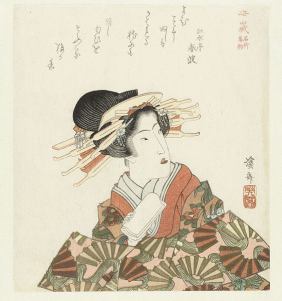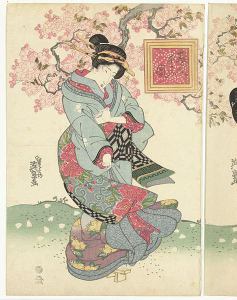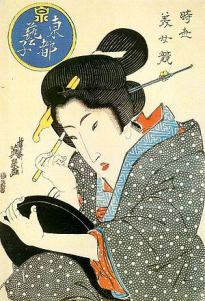Japanese Art and the Reality of Life in the Edo Period: Keisai Eisen and Early Years
Lee Jay Walker
Modern Tokyo Times
The artist Keisai Eisen (1790-1848) battled through the ravages of poverty and the reality of family deaths throughout the early part of his life. In a sense, Keisai Eisen represents a reality that existed for many Japanese nationals during the Edo period. This applies to family bereavement, economic hardship and initial ambitions that had to be negated based on the reality of life.
In truth, the floating world of ukiyo-e was based on the backdrop of reality, unreality, and that tomorrow may never come. Of course, artists in this period of Japanese history represent various material backgrounds. Similarly, the target market varied on the individual artist, economic needs, depending on past influence and other important factors.
Keisai Eisen therefore responded to the reality that he found himself in. Yet, despite the hardship he faced this fascinating artist refused the easy way out. Instead, Keisai Eisen focused on being tenacious and working himself out of poverty.
In an earlier article I comment: “…for individuals like Keisai Eisen, then the real world was about death, hardship, and seeing the world for what it is. Yet this didn’t mean “weakness” or “pity,” on the contrary, for Keisai Eisen this led to him being independent because he refused economic help from family relatives when he was a young man.”
Initially, Keisai Eisen desired to be a professional kyogen writer because traditional theater in Japan appealed greatly to this flamboyant artist. The kabuki/kyogen writer Namiki Gohei taught Keisai Eisen when he was young. However, family bereavement and economic hardship meant that Keisai Eisen believed that art was the best option for him to alleviate his poverty. Therefore, his dream of being a kyogen writer became a backburner.
At an early age his mother passed away therefore his stepmother and father became instrumental for Keisai Eisen. Yet after some normality returned to his life then when he reached 20 years of age this all collapsed once more. This is based on his father and stepmother dying in the same year. Given this harsh reality, then Keisai Eisen believed that he had an obligation to his three sisters alongside defending himself financially.
In a past article I state “Keisai Eisen distinguished himself in the field of ukiyo-e and his literature is also highly regarded. Indeed, some individuals believe that he was a ghostwriter for Tamenaga Shunsui and Yoshimi. These two writers of ninjou-bon (stories focused on ordinary people) were popular during this period of Japanese history but nobody can say with 100 per cent certainty about this reality.”
Overall, the early years for Keisai Eisen were based on hardship and family deaths. However, despite everything Keisai Eisen overcame negativity based on his early strong spirit.
http://www.toshidama-japanese-prints.com/item_171/Eisen-Young-Woman-Walking-Under-an-Umbrella.htm
http://www.toshidama-japanese-prints.com
http://toshidama.blogspot.com/
Modern Tokyo News is part of the Modern Tokyo Times group
http://moderntokyotimes.com Modern Tokyo Times – International News and Japan News
http://sawandjay.com Modern Tokyo Times – Fashion
https://moderntokyonews.com Modern Tokyo News – Tokyo News and International News
http://global-security-news.com Global Security News – Geopolitics and Terrorism
PLEASE JOIN ON TWITTER
https://twitter.com/MTT_News Modern Tokyo Times
PLEASE JOIN ON FACEBOOK




